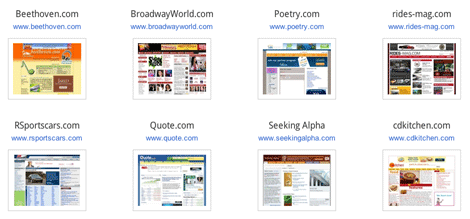The Display Network is a collection of websites -- including specific Google websites like Google Finance, Gmail, Blogger, and YouTube -- that show AdWords ads. This network also includes mobile sites and apps. If you've ever seen an AdWords ad on your favorite news site or in your Gmail account, and wondered how it got there, now you know: websites like these are part of the Google Display Network.
When showing ads on the Display Network, you can reach a wide range of customers with broad interests, choose which sites or pages to appear on, and engage users with appealing ad formats.
- Reach new customers: Capture someone's attention at different points in the buying cycle. For example, if you run an art supply store, you can catch a mom's eye when she's reading reviews about the best brands of washable paints, but before she puts her toddler in the car seat and heads out to buy.
- Select where your ads appear: Within the Display Network, you can choose more specifically where you want your ads to appear -- you can select types of pages or specific websites for your ads, as well as audiences to show your ads to.
- Engage users with appealing ad formats: Text, image, video, or rich media formats can appear on the Display Network.
The reach of the Display Network
From millions of websites, news pages, and blogs to Google websites including Gmail and YouTube, the Display Network can help you show your message to more customers.
The Display Network reaches 90% of Internet users worldwide and includes more than 2 million publisher sites like nytimes.com and weather.com (Source: Comscore 2013).
Examples of Display Network websites
Here are some examples of Google Display Network websites:

Matching your ad to sites in the Display Network
Finding the right audience across millions of websites can be difficult. The Google Display Network lets you put your message in front of potential customers at the right place and at the right time in several ways.
- Reach users by keywords and topics: Using contextual targeting, AdWords finds the best places for your ad across the Google Display Network, based on your keywords. This can help you show your ad to an audience that’s interested in your business and more likely to take action.
- Choose specific sites or pages: Put your message on the websites you think are the best match for your business using placement targeting. By adding managed placements, you can show your ad on specific webpages, online videos, games, RSS feeds, and mobile sites and apps that you select. You can even block your ads from sites you don't think are relevant.
- Find users who are already interested in what you have to offer: Show your ads on Display Network websites to specific groups of people. You can reach people who visited your site before by creating a remarketing campaign, or customers interested in specific categories, by adding interest categories. Then, you can show them highly relevant messages as they browse other sites on the Google Display Network.
Example
If you offer dog training services in New York, you could reach customers on the Display Network in these ways:
- Add the keyword "puppy training" and you might be automatically matched to a blog about dogs.
- Identify a site selling puppy toys that you want your ads to show on, and add the site as a managed placement.
- Use remarketing to show your ads to customers who have previously visited your site -- even if they're browsing pages about kayaking instead.
About two specific types of sites on the Display Network:
Ad types on the Display Network
In addition to the text ads you'll see in Google search, sites on the Display Network show other types of visually engaging ads, too. Here's a list of ad formats you can use to attract customers on the Display Network:
- Text ads

- Image ads - ads that include photos or artwork

- Rich media ads - ads with animation or other types of motion
- Video ads

Deciding if the Display Network is right for you
If you're interested in attracting customers and delivering a compelling message about your business, advertising on the Display Network can work for you. Display ads -- for example, video or image ads -- can really boost the performance of your online ad campaigns and leave an impression on customers.
Here are some common goals that you can achieve by advertising on the Display Network:
- Sell more products or services
- Build customer loyalty
- Engage with customers
- Increase brand awareness
Measuring effectiveness of ads on the Display Network
To make sure you're achieving your business goals with the Display Network, you can also review detailed reports.
- Reports: See exactly on what webpages your ad ran, which ads deliver the most clicks, and which sites give you the most sales for the lowest cost. By segmenting your ad's performance by network, and by tracking its performance on individual Display Network placements, you can see when and where it performs best. Then, you can adjust your targeting and bidding strategy to get the most bang for your buck.
- Value: If our data shows that a click from a Google Network page is less likely to turn into actionable business results -- such as online sales, registrations, phone calls, or newsletter signups -- we may automatically reduce the bid for that site, charging you less for the same click.
Case studies
Learn from fellow advertisers' experience by checking out these examples of advertisers who found the Display Network was right for them:
- Carnival Cruise Lines used contextual targeting on the Google Display Network to increase bookings by 284% in five weeks, saw a 72% decrease in cost per conversion, and 36% increase in leads.
- The Jordan Brand used the Google Display Network to target niche audiences and improve brand awareness and engagement.
- Yankee Candle used remarketing on the Google Display Network to re-engage shoppers, increase conversion rates by 600%, and cut cost-per-conversion in half.

0 comments:
Post a Comment